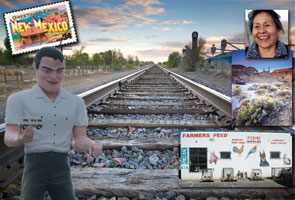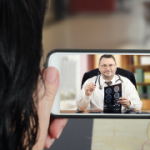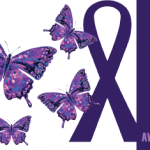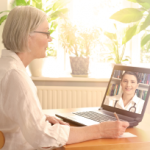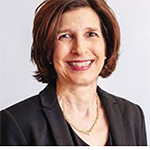Should you be driving through New Mexico and see a sign that says, “Last Gas for 50 Miles,” take it seriously. The scarcity is very real. New Mexico, known as the Land of Enchantment, is the fifth largest state in the union, yet is home to a half million fewer souls than live in the jam-packed 72 square miles of Brooklyn. Practicing medicine in this enchanted land of often sublimely beautiful, profoundly empty, wide-open spaces are exactly 19 rheumatologists. That scarcity is also very real, and the impact on patient care could not be more serious.
Attempting to populate this healthcare void is Project Extension for Community Healthcare Outcomes (ECHO) an initiative that is training family doctors, physician assistants (PAs), and nurse practitioners (NPs) to treat uncomplicated rheumatologic sequelae that do not require critical care. “There is a dire shortage of rheumatologists in rural areas of New Mexico,” says Sanjeev Arora, MD, professor of medicine at the University of New Mexico Health Sciences Center (UNMHSC), Albuquerque, and founder of Project ECHO. Currently, the average wait to see a specialist ranges from six to eight months at UNMHSC’s Albuquerque facility.
This disparity is not unique to rheumatology. In fact, Dr. Arora is a gastroenterologist and initially conceived of ECHO in 2002 to address the treatment needs of patients with hepatitis C virus (HCV). “In the prison system alone, there were over 2,000 individuals that were diagnosed at that time, yet not a single one had been treated.” With 30,000 additional HCV patients statewide, the need was obvious. Yet, as with rheumatology, the providers simply weren’t there. “I had to figure out a way to treat these underserved populations,” Dr. Arora says. To do that, he realized he needed to bring nonspecialist providers into the picture. “The question to me was, how do you bring that care to these populations without compromising quality?” The answer: Project ECHO.
The idea was rather straightforward and consisted of four parts. First, use technology (telephone/Internet) to leverage specialty resources—in essence, telemedicine. Second, develop standards of practice protocols for the treatment. “I derived a protocol—the same one I use in my clinic—to share with providers in rural areas. If they learned how to use it, they would be giving the same quality of care as me,” Dr. Arora says. Third, reinforce training with case-based learning—a mini grand rounds of sorts, but done remotely; and fourth, develop tools to assess training outcomes. “I thought if we could do all four, then we could provide the same level of care in a remote area that we would at the university,” Dr. Arora says.
And he was right. Once word got out, interest in ECHO HCV by rural providers was immediate, the results were excellent, and wider recognition soon followed. In August 2007, Project ECHO was one of three winners chosen (out of 300 entrants) to receive the Disruptive Innovation in Healthcare Award, sponsored by the Robert Wood Johnson Foundation. The award, citing the ingenuity of this “one-to-many” knowledge network, included a $5-million grant for the continued operation and expansion of the ECHO program.
ECHO Rheumatology
Entering its fifth year in operation, and under the guidance of Arthur Bankhurst, MD, professor of medicine and chief of rheumatology at UNMHSC, the ECHO rheumatology section has made significant inroads down many an unpaved lane. “Long ago I recognized the limitation of the rheumatology subspecialty practice throughout the state,” Dr. Bankhurst says. Reasons for this vary, although many are financial. Regardless, the average age for rheumatologists here and nationwide is 55 to 60, he notes. “For the next generation, there is going to be an increasing lack of the rheumatology subspecialty most anywhere you go.” Compounding this dearth in New Mexico is distance. It is not unusual for Dr. Bankhurst to see patients who are driving 600 miles round-trip for the privilege, and this after a months-long wait just to get in. “When I spoke to Dr. Arora about these issues, he very graciously invited me into the ECHO network,” Dr. Bankhurst says.
As with HCV, training in rheumatology would be based on the rudiments of standards of care. “My goal was to see to it that the most common rheumatologic patient problems (uncomplicated cases) could be treated at a distance just as well as they could be in my clinic,” Dr. Bankhurst says. A majority of these connective tissue–disease problems, he estimated, could be handled at a distance by prescribing medications that ordinarily a general practitioner, NP, or PA would be reluctant to use. The ECHO experience would overcome that barrier.
So what is being taught through ECHO? “Early rheumatoid arthritis [RA] can be a subtle diagnosis, so my first emphasis is instructing on how to be able to recognize signs,” Dr. Bankhurst explains. This includes a review not only of radiographic evidence but of the increasingly available but sometimes difficult to interpret molecular diagnostics associated with rheumatologic disease. Following this, the participant’s general medical knowledge is inculcated with rheumatology protocols. “We instruct on the usual paradigms for treatment,” Dr. Bankhurst says. “If it’s RA, we’re using hydroxychloroquine or methotrexate, as well as the combination of biologic agents.” Once ECHO trained, a provider’s reluctance to treat is supplanted by a familiarity with dosing levels and adverse events. “They can handle it, particularly in RA,” Dr. Bankhurst comments. “If you ever listened in on one of my sessions, you would be surprised at the [specialist] level of sophistication that is quickly developed at these remote sites.” He points out that these sites are now as close as the nearest modem. “Wherever the Internet goes, we can potentially go,” he says.
Getting Started
To initiate any type of ECHO, you have to first speak up. “Dr. Bankhurst and I did a lot of educational outreach,” says Jeanne Boyle, RN, BSN, and executive nurse manager of ECHO at UNMHSC. “To gauge interest in the program, we did presentations all over the state in places like, say, the Bayard Community Health Clinic, where you might be talking to just two people.” Boyle also contacted CEOs of hospitals and sponsors of small clinics, among others. “I even called nurses that I knew—any means available to bring the case for [expanding rheumatology services] to the whole state,” she says.
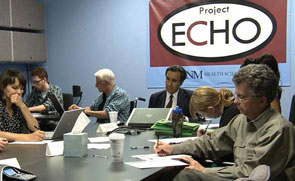
Critical to this effort was attitude, Boyle stresses. “In building grassroots interest, you have to let those folks know that it’s not the academic health science center that’s telling them what they need to do, it’s you asking, ‘How we can serve you?’ ” That’s the core of ECHO.
Initially, the needs out in the field may be technical—minimally, you need a phone. Ideally, you need a computer with a webcam and a good Internet connection. If you don’t have such items or capabilities, ECHO will provide materials and tech support free of charge. “In larger clinics with multiple ECHO participants, we can install a polycom system so everybody can see/hear everybody,” Boyle says. This is also free, as is the entire training program, including CME credits, and certification registration in the ARHP Advance Rheumatology Course, an online program consisting of 19 core, adult, and pediatric modules.
She and Dr. Bankhurst had previous knowledge of the ARHP’s online course, but the $1,500 fee for participation was beyond most rural providers. ECHO worked with the ARHP to arrange a price per use that could be readily absorbed by ECHO’s overall budget. With cost considerations then set aside, Boyle felt that, if providers were willing to complete the course, it would demonstrate a commitment to ECHO and incentivize participation by offering this advanced rheumatology program certification. Health professional participants also received a year-long membership to the ARHP and its wealth of rheumatology resources. “We got a huge response to that,” says Boyle. “Our clinic participation doubled in one month.”
The ECHO process kicks off with interested parties coming to Albuquerque (expenses paid) for two days of intensive training—a “mini-residency” as Boyle puts it. “They go to an injection clinic and learn how to inject various joints, they learn about the meds, they take care of patients in our clinic with Dr. Bankhurst’s supervision,” Boyle says. If all goes well, access to the online course is provided, and training then continues remotely. To broaden education and assess training outcomes, ECHO participants are asked to present 10 cases a year to the rheumatology clinic to demonstrate knowledge of best practices, “to ensure that they are actively looking at how to translate this information to their particular patient population,” Boyle says.
Though the issue of material costs has been dealt with, there still remains the expense of time. “Our clinicians tune in during their lunch hour because they’re not allowed by their health facility to participate in any other way,” Boyle says. She hopes that this conflict can be addressed with the just-announced initiative to have payers reimburse clinics for the provider’s ECHO online presentation time; the coding is still to be worked out, but the reasoning is sound—this activity is obviously patient related.
Reach Out, Reap Rewards
“I didn’t find ECHO, really, though I’d heard of it,” says Dominic Tellez, PA, of Ben Archer Health Center in Radium Springs, N.M. “ECHO found me.” Dr. Bankhurst had given his ECHO/rheumatology presentation in the area, and Tellez was intrigued. “I didn’t know much about rheumatology, so I started listening in and eventually signed up for the training modules, and went up [to Albuquerque] for the hands-on training. I’ve hung in there ever since,” he says.
Radium Springs, a community of roughly 2,000 individuals, mostly farm workers, many indigent, was in dire need of providers of any kind. “I thought that this opportunity was awesome,” says Tellez. “Less than 30% of my patients are insured, and their access to specialists is near to none. When I heard that there’s a rheumatologist that I can present my patient’s cases to I thought, ‘Let’s go for it.’ ”
Online Resources
- For more information on participating in or starting an ECHO program, go to: http://echo.unm.edu.
- For more information on the ARHP Advanced Rheumatology Course and to register, go to www.rheumatology.org/education.
Prior to ECHO, there was little help that Tellez was willing to offer to patients with rheumatologic disease. “I was very scared to start a lot of these medications. Methotrexate [is] one of the staples of treatment, [but] I was very uncomfortable starting it, or even managing patients that came to me already on it. So, now, [having completed the training] I’ve become quite a bit more comfortable.”
Despite the time commitment required for ECHO training, which Tellez admits he underestimated, the rewards have been well worth it. “There’s this patient I see now,” he says with obvious pride, “She’d been in Mexico for some time and was off of her methotrexate—she was getting a dose here and there—so when I presented her case, I proposed restarting her on a pretty hefty dose. After my presentation, Dr. Bankhurst said, ‘Hey, you’ve come quite a way. [The proposed treatment] is very appropriate.’ So, that really stands out in my mind.”
Fellow ECHO graduate Raymond Galley, PA-C, of La Familia Medical Center in Santa Fe, has enjoyed similar success. He is particularly impressed with the way the training is approached. “The whole point of Project ECHO is to broadcast the specialist perspective as it applies to those in primary care,” he says, and this is reinforced by participant interaction. “The collegial atmosphere, and the knowledge of other providers—I like that,” Galley says. “It’s also interesting to hear that others have the same issues that I do as far as delivering healthcare to people without a lot of resources.”
At first thought, Santa Fe, with a population 143,000, may not seem to qualify as underserved, but Galley points out that the city and surrounding area has many low-income residents and high numbers of uninsured immigrants. There is a great need for rheumatology expertise amongst this population. Galley, a recent ECHO graduate, is forthright in his opinion: “With this training, I’ve already changed patients’ lives.”
The Middle of Nowhere and Beyond
Could ECHO work elsewhere? Without a doubt, says Galley. “I hope it happens all over the country, because there’s this growing medical problem of patients who can’t afford care,” or can’t get to the healthcare provider. For them, he says, “ECHO hits that target.” the rheumatologist
Neil Canavan is a journalist based in New York.
